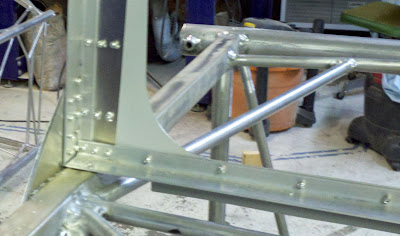I occasionally publish portions of the Belite assembly manual, which will help you build your very own ultralight airplane. Here we go with another installment:
Mating the Rear Fuselage to the pre-welded Aluminum
cabin
In this section, you are going to mate your rear riveted aluminum
fuselage to the cabin. This is done by
leveling both sections very carefully, trimming the length of the aluminum
longerons on the rear, and then riveting on gussets.
This isn’t too tough to do, let’s get going!
1. Level
the cabin and the rear fuselage. Using
blocks and a level, ensure that the top of the cabin is level. Although only one level is used in the photo,
make sure it is also level side to side.
 |
| Figure 1 -- Level the cabin |
You’ll notice the small stubs pointing backwards on the
photo above, along the bottom of the fuselage.
Current production cabins no longer have the stubs.
 |
| Figure 2 -- Level the rear fuselage |
2. Trim the longerons on the rear fuselage.
All four of the rear fuselage longerons are trimmed butt
flush to the cabin. Also, the top skin
will need some trimming to make it fit.
Remember to keep everything level, even as you move the rear
fuselage around.
 |
| Figure 3 -- Longeron and top skin trim on rear fuselage |
3. Attaching
the gussets.
You’ll need to clamp gussets in place. The gussets are 4” triangular, made from
6061T6 .040 aluminum; you’ll double all side gussets. Singled gussets on the bottom are OK.
 |
| Figure 4 -- Clamping the gussets |
Note that this prototype fuselage, shown above, used a
square gusset on the bottom. You’ll use
a triangular gusset on the bottom instead.
You’ll need to trim it so it fits around the strut attach post. Use doubled gussets on the side.
[ALSO NOTICE, in the
above picture, that a string has been run from the front of the plane to the
rear of the fuselage. This is a helpful
aid to keeping everything lined up.]
 |
| Figure 5 -- starting to rivet the doubled gusset |
You need to do this with doubled gussets on the top and the
bottom of each side. Then you need to do
it one more time on the bottom of the fuselage.
If you are missing gussets from your kit, give us a call and
let us know that you need 4” triangular gussets – we’ll drop them in the mail
to you. We precut them on our shopbot
and they look great. (You’ll need to
deburr them).
A few more rivets, and the double gusset plates are in
place:
 |
| Figure 6 -- Rivets on doubled gusset plate |
4. Fitting
the top skin
In order to attach the top skin, you will need to rivet an
angle cross brace to the cabin, where the top skin will rivet down. You should use a piece of 0.875 x 0.500
aluminum angle.
 |
| Figure 7 -- cross fuselage top skin support |
The cross support is riveted to the cabin using two rivets
on each side.
The next step is to slip a couple of aluminum strips under
each side of the top skin.
 |
| Figure 8 -- Aluminum strips |
 |
| Figure 9 -- aluminum strips slipped in |
The strips fill the gap from the top skin to the longerons
on the side. After we are happy with the
setup, we will rivet everything in place.
[NOTICE: The bottom side gussets are still the old
style in the above photo, and the bottom fuselage gussets are completely missing. Do not make this mistake on your airplane.]
 |
| Figure 10 -- top skin riveted down |
 |
| Figure 11 -- top skin, from underneath |
Make sure you deburr the top skin, all the way around the
edges. You are now ready to mount
control hardware to the fuselage, and then you’ll prime the fuselage.

No comments:
Post a Comment